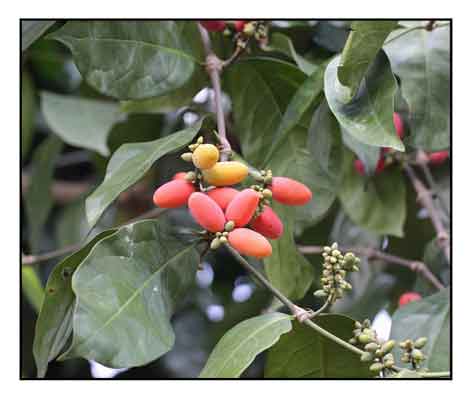 Gen info Gen info
- Gnetum is a genus of gymnosperms, the sole genus in the family Gnetaceae, consisting of tropical evergreen trees, shrubs and lianas. Unlike other gymnosperms, they possess vessel elements in the xylem. (3)
- Gnetum is one of the oldest species of trees on Earth, dating back more than 200 million years.
It is the sole genus with about 30 species.
(6)
- The species epithet gnemon derives from "genemo", the species vernacular name in the Moluccas islands.
(4)
-
Gnetum gnemon derives from Latin, both from the Moluccan name of the tree, ganema.
Botany
Trees or shrubs, up to 22 m tall and 40 cm diam, without buttresses; sometimes a climbing shrub. Crown narrow, cylindrical, with a single trunk. Bark gray, marked with conspicuous or faint rings. Leaves thin, yellow when dry, tapering at both ends, but varying in shape and size, 7.5-20 × 2.5-10 cm; secondary nerves bent, joining; petiole 6-18 mm. Inflorescences solitary, axillary, simple or once branched, yellowish, 3-6 cm long, collars 3 mm broad. Flowers with broad sporophyll, twice as long as the perianth (3 mm). Sterile flowers globose, tipped or beaked, 2 mm thick, 10-15 in a ring. Inflorescences similar. Flowers 5-8 at each node, globose, tipped or beaked, 3-4 mm long, inner tube exserted by 1 mm. Fruit ripening yellow, then orange-yellow or pink, sessile (exceptionally stalked), ellipsoid, shortly apiculate, 1-3.5 cm long, almost velvety; middle envelope ribbed (Markgraf 1951).
(4)
B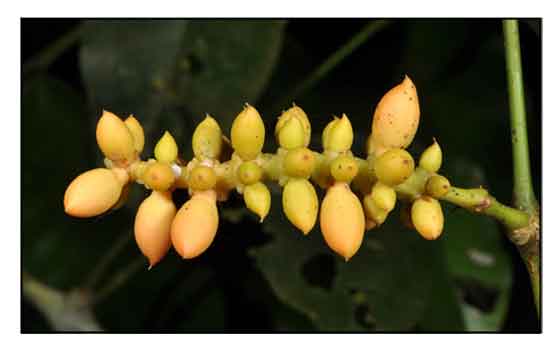 ago is a small to medium-sized tree reaching a height of 10-15 m and a diameter up to 40 cm. Bole is cylindrical with numerous branches; crown is compact to conical in shape. Leaves are opposite, variable in size and shape, 10-20 cm long and 4-7 cm wide, oblong-ovate to lanceolate, dark green, shiny, smooth, and usually pointed at both ends. Inflorescences are borne on young shoots and older branches. Fruits are produced in small clusters, 2.3 to 3.5 cm long, oblong with smooth red skin. (The immature fruit is green turning orange-red when fully ripe.) Seed is enclosed in a fleshy covering about 1 mm thick. Seed coat is thin and brittle, separating readily from the seeds. (16) ago is a small to medium-sized tree reaching a height of 10-15 m and a diameter up to 40 cm. Bole is cylindrical with numerous branches; crown is compact to conical in shape. Leaves are opposite, variable in size and shape, 10-20 cm long and 4-7 cm wide, oblong-ovate to lanceolate, dark green, shiny, smooth, and usually pointed at both ends. Inflorescences are borne on young shoots and older branches. Fruits are produced in small clusters, 2.3 to 3.5 cm long, oblong with smooth red skin. (The immature fruit is green turning orange-red when fully ripe.) Seed is enclosed in a fleshy covering about 1 mm thick. Seed coat is thin and brittle, separating readily from the seeds. (16)
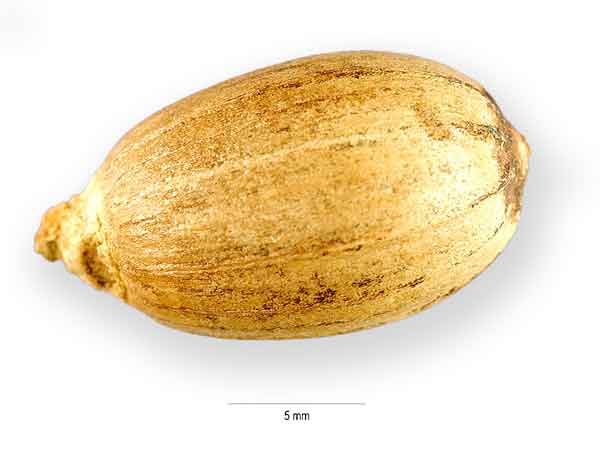 Distribution Distribution
- Native to the Philippines.
- Found in Bataan, Batangas, Camarines Provinces, Ilocos Norte, Laguna, Leyte, Mindanao,Mindoro, Palawan, Panay, Quezon,
Samar, Siargao, Sibuyan.
- Also native to Assam, Bismark Archipelago, Borneo, Caroline Is., China, Fiji, Lesser Sunda Is., Malaya, Maluku, Myanmar, New Guinea, Nicobar Is., Queensland, Santa Cruz Is., Solomon Is., Sulawesi, Thailand, Tibet, Vietnam. (2)
- Cultivated as a fruit tree.
Constituents
- Yields bioactive compounds like saponins, tannins, and flavonoids. Seeds yield an abundance of resveratrol (stilbenoid) mainly
in the form of dimers (gnetin C). (4)
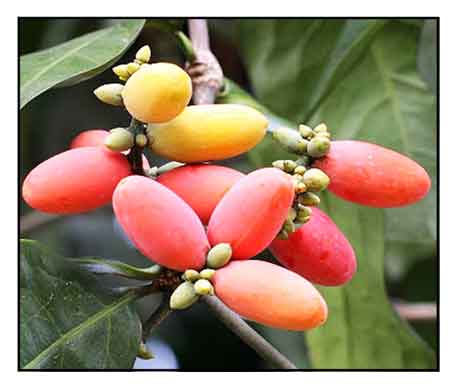 - Preliminary screening of G. gnemon var. ternerum leaves showed pH of approximately 6.0, and in g/100 g, dried leaves contain 27% protein, 56.8% carbohydrates, and 36.3% total dietary fiber,and vitamin A at 3,706 µg/100 g. Mineral content was highest in N at 1.3 g/100, followed by K, P, Mg, Na, and Ca at 0.4 g, 0.3 g, 0.25 g, 0.2 g, and 0.16 g/100 g sample, respectively. Micronutrients including Zn, Mn, Cu, and Fe at 0.22, 0.21, 0.18, and 0.09 g/100 g sample were recorded in Indonesia from G. gnemon leaves. Consumption of fresh leaves will provide only 57 kcal/100 g from the edible portion, with moisture, protein, fat, carbohydrate, crude fiber, and ash contents of 81.7, 4.2, 1.5, 6.6, 4.7, and 1.3 g/100 g, respectively (Hoe & Siong, 1999). The anti-nutritional factors in leaves of G. gnemon include arsenic, phytic acid, and tannins (0.07, 1.52, and 1.52 µg/g, respectively) but no cyanide, lead, or alkaloids. Seed flour yielded protein 19.0 g/100, crude fiber 8.66/g 100, carbohydrate 64.1 g/100, and total dietary fiber 14.5 g/100 on a dry basis. (6) - Preliminary screening of G. gnemon var. ternerum leaves showed pH of approximately 6.0, and in g/100 g, dried leaves contain 27% protein, 56.8% carbohydrates, and 36.3% total dietary fiber,and vitamin A at 3,706 µg/100 g. Mineral content was highest in N at 1.3 g/100, followed by K, P, Mg, Na, and Ca at 0.4 g, 0.3 g, 0.25 g, 0.2 g, and 0.16 g/100 g sample, respectively. Micronutrients including Zn, Mn, Cu, and Fe at 0.22, 0.21, 0.18, and 0.09 g/100 g sample were recorded in Indonesia from G. gnemon leaves. Consumption of fresh leaves will provide only 57 kcal/100 g from the edible portion, with moisture, protein, fat, carbohydrate, crude fiber, and ash contents of 81.7, 4.2, 1.5, 6.6, 4.7, and 1.3 g/100 g, respectively (Hoe & Siong, 1999). The anti-nutritional factors in leaves of G. gnemon include arsenic, phytic acid, and tannins (0.07, 1.52, and 1.52 µg/g, respectively) but no cyanide, lead, or alkaloids. Seed flour yielded protein 19.0 g/100, crude fiber 8.66/g 100, carbohydrate 64.1 g/100, and total dietary fiber 14.5 g/100 on a dry basis. (6)
- Bioassay guided study isolated 2,3-dihydroxypropyl icosanate (1), oleic acid (2) and ursolic acid (3). (see study below) (7)
- Study of EtOAC-soluble extract of leaves isolated a new phenylheptanoid, gnetumal (1), along with five known compounds (2-6). (see study below) (11)
- Study showed seed flour
to be rich in protein (19.0 g/100g), crude fiber (8.66 g/100g), carbohydrates (64.1%), total dietary fiber (14.5%), and adequate amounts of essential amino acids, fatty acids, and minerals. Antioxidant compounds such as total phenols (15.1 and 12.6 mg GAE/100g), tannins (35.6 and 16.1 mg CE/100 g), and flavonoids (709 and 81.6 mg CEQ/100 g) were higher in ethanolic extracts than aqueous extracts, respectively. FTIR spectral analysis showed seed flour to encompass major functional groups such as amines, amides, amino acids, polysaccharides, carboxylic acids, esters, and lipids. (see study below) (17)
- Seeds yield mainly dimeric stilbenoid compounds, namely: gnetin C (1), gnemonoside A (2), gnemonoside D (3), along with resveratrol (4). (see study below) (21)
- Study of fruit-bark using fractionation column chromatography results in 3 isolates A-C with presumption of containing five stilbene derivative compounds (isorhapontigenin, resveratrol, gnetin D, gnetifolin K, gnetol) and one lignan compound ((+)-lirioresinol B). (See study below) (24)
- Proximate analysis has shown that Gnetum leaves stand out for their high protein and dietary fiber content from 4.1-4.2 g/100 g fresh weight (FW) and from 4.7-6.5 g/100 g FW, respectively, while fat content is low. Leaves are rich source of copper, vitamin K and A with 0.85-12.1 ppm or 166.67-94.45% DV, 332.8 µg and 627.2 µg or 416% and 78% DV, respectively.
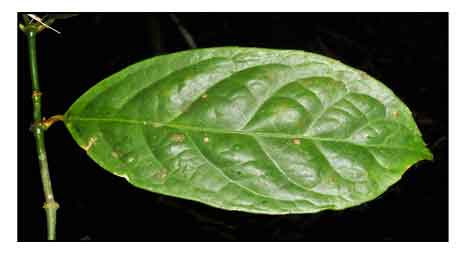 Properties Properties
Studies have suggest antitumor, tyrosinase inhibitory, antioxidant, antiplasmodial, hypouricemic, hypolipidemic, angiotensin enzyme inhibitory, immunomodulatory, antidiabetic, analgesic properties.
Parts used
Roots, seeds, leaves.
Uses
Edibility
- Fruit is edible. Embryo is pounded and eaten roasted; also cooked in soup. (4)
- Both fruit peel and kernel with white-yellow flesh are sweet when ripe.
- Flush and inflorescences are cook in soup or eaten as vegetable. Raw, it causes a little itching in the mouth.
(4)
- Young leaves and tender tip or apex used as fresh vegetables and/or cooked.
(6) Young leaves are reddish orange to light green in color with a sweet creamy taste, which turn to dark green indicating older stage or intermediate young state, and can be prepared in several dishes, cooked with eggs, in curries, coconut milk soup, or as fresh wrap with other foods. (29)
- In Java, kernels of large seeds are beaten into a flat cake, fried, eaten hot or allowed to cool and eaten like potato crisps. (4) Seed kernel processed into flour for crisps making, a home industry in Java. (6)
Folkloric
- No reported folkloric medicinal use in the Philippines.
-
Used for the treatment of bronchitis, arthritis, and asthma. (5)
- Roots used as antidote for poison and as medicine for malaria.
- In Malaysia, ripe fruits eaten for stomach cleansing and to prevent constipation. (36)
Others
- Fiber: Inner bark provides a fiber, processed into making rope and cord, string bags (bilum), fishing nets and paper products. The inner bark is famous for the making of Sumba bow string.
- Wood: Soft timber is used for making boxes, tool handles, wharfing rafts and boats; branches used for making barrels.
Studies
• Antiplasmodial / Cytotoxicity / Leaves: In a preliminary study, the ethanol extract of leaves of G. gnemon showed promising antiplasmodial activity against Plasmodium falcifarum chloroquine sensitive (3D7) strain in vitro with IC50 of 29.4 µg/mL. Bioassay guided study isolated 2,3-dihydroxypropyl icosanate (1), oleic acid (2) and ursolic acid (3). Compound 3 showed highest antiplasmodial activity with IC50a of 4.0 and 6.0 µg/mL against chloroquine sensitive (3D7) and resistant (Dd2) strains of P. falcifarum, respectively. The isolated compounds showed low cytotoxicity against rat skeletal muscle (L6) and human cervical cancer (HeLa) cells. The isolated compounds may be responsible for the antimalarial activity. (7)
• Antioxidant / Cytotoxicity Against HeLa Cell Line / Seeds: Study evaluated the invitro antioxidant and cytotoxic effects of melinjo seed fractions against HeLa line. DPPH scavenging activity of seed aqueous, ethyl acetate and N-hexane fraction was 733.12, 68.40 and 2035.70 µg/mL respectively. The ethyl acetate fraction was most active against HeLa cell line with IC50 of 45.27 µg/mL. Results showed antioxidant and cytotoxic activity against HeLa cell lines, which may be attributed to phytochemicals and stilbenoids such as resveratrol and gnetin. (8)
• Decreased Serum Uric Acid / Increased HDL / Seeds / Clinical Trial: Seed extract contains trans-resveratrol (3,5,4'-trihydroxy-trans-stilbene) and other derivatives. A double-blind, randomized controlled study evaluated the beneficial effects of melinjo seed extract (MSE) in healthy adult males. The MSE significantly reduced serum uric acid and increased HDL cholesterol. MSE, trans-resveratrol, and a resveratrol dimer, gnetin C (GC) significantly inhibited AT1 receptor binding and exhibited mild agonistic activities for PPARα and PPARγ. Results showed MSE may decrease serum uric acid regardless of insulin resistance and improve lipid metabolism by increasing HCL cholesterol. (9)
• Antioxidant / Leaf and Bark: Study evaluated the antioxidant properties of methanol, ethanol, boiling water, hexane and chloroform extract of leaves and bark of G. gnemon. The highest antioxidant property in the leaves was in the water extract (80.89%) while the lowest was in the hexane crude extract (61.61%) at concentration of 300 µg/ml. The highest activity in the bark was in the crude ethanol extract (72.61%), the lowest in the chloroform crude extract (46.67%) at 300 µg/ml. Results suggest a potential source of natural dietary antioxidants to replace synthesized antioxidants that might have carcinogenic effects. (10)
• Antitumor / Seeds: Study evaluated the antitumor activity of melinjo seed extract (MSE) and active ingredient, gnetin C (GC), using human and murine tumor cell culture models in vitro. Antitumor activity of GC was compared with trans-resveratrol (tRV), a stilbenoid polyphenol. Results showed MSE and GC significantly inhibited the proliferation of pancreatic, prostate, breast, and colon cancer cell types (p<0.05), without affecting normal cells. GC enhanced antitumor activity more than tRV (p<0-.05). MSE and GC significantly induced apoptosis in all cancer cell line. MSE might induce apoptosis in cancer cells via caspase-3/7-dependent and -independent mechanisms. Results suggest MSC and GC have potent antitumor activity and provides evidence that MSE inhibits tumor growth, intratumoral angiogenesis, and liver metastasis in colon-26 tumor-bearing mice. (11)
effects. (10)
• Gnetumal / New Phenylheptanoid / Tyrosinase Inhibitory / Leaves: Study of EtOAC-soluble extract of leaves isolated a new phenylheptanoid, gnetumal (1), along with five known compounds (2-6). Gnetumal (1) and p-coumaric acid (5) showed potent tyrosinase inhibitory activity with IC50s of 31.6 and 2.3 µM, respectively, more potent than positive control kojic acid (IC50 44.6 µM). (12)
• Anti-Streptococcus mutans in Dental Caries: Streptococcus mutans is a bacteria involved in the pathogenesis of dental caries. Study investigated the effect of G. gnemon extract on bacterial viability, growth inhibition, acid production, glucosyltransferase enzyme formation, and the ability of adhesion of S. mutans ATCC 25175, in vitro. Results suggested Gnetum gnemon extract can inhibit the growth and adhesion of S. mutans in vitro. (13)
• Activity Against pBSKS DNA Cleavage / Cytotoxicity / Seed Protein: Study evaluated the activity of a protein fraction isolated with DEAE and BUTYL matrices against supercoiled DNA cleavage of pBSKS. The DEAE and BUTYL protein fractions results in depletion of supercoiled DNA bands of pBSKS. Results showed the activity of protein isolates were non-toxic with IC50 >1000 g/mL. Melinjo fractionated using DEAE-650M against T47D cells with IC50 of 127.62 g/ml could be categorized as quite active and cytotoxic. (14)
• Angiotensin Converting Enzyme Inhibitory Activity / Antihypertensive / Seed: Study evaluated the angiotensin converting enzyme (ACE) inhibitory activity of melinjo seed extract and studied the molecular docking of stilbene contained in melinjo seeds. An ethyl acetate extract showed highest ACE inhibition activity (50% value of 9.77) and highest phenolic content (575.9 mg GAE/g). LC-MS analysis of EA extract yielded resveratrol, gnetin C, viniferin, and gnemonoside A/B, compounds that displayed similar physiochemical properties to lisinopril, an ACE inhibitor. In silico docking studies demonstrated they fit into the lisinopril receptors. Results showed the EA extract of seeds exhibited highest ACE inhibitory activity. Molecular docking studies suggest resveratrol dimers, gnetin C and gnemonoside A, can be considered ACE inhibitors. (15) (also see 34 below)
• Seed Flour as Base for Food Products: Study evaluated Belinjau (Gnetum gnemon) seed flour was evaluated for nutritional composition, antioxidant activity, and functional properties. Inhibition of DPPH was high in ethanol extracts (48.9%) compared to aqueous extract (19.7). The seed flour exhibited excellent nutritional, functional and antioxidant properties. It was rich in protein, dietary fiber, carbohydrates, and mineral with acceptable levels of essential amino acids and fatty acids. Results suggest the seed-flour can be modulated to develop new food formulations. (see constituents above) (17)
• Stilbenoids / Immunomodulatory / Potentiation of T-Cell Immune Responses: Study evaluated melinjo fruit for regulatory actions on ileal immune responses. Oral administration of 50% ethanol extract at 100 mg/kg/day significantly enhanced production of Th1 cytokines IL-2 and IFN-γ irrespective of concanavalin-A stimulation. 1D and 2D NMR and MS analysis yielded glucosides gnemonoside L (5) and gnemonoside M (7) and identified five known stilbenoids, namely resveratrol (1), isorhapontigenin (2), gnemonoside D (4), gnetins C (3) and E (6). Only the new stilbenoid, gnemonoside M (7) enhanced TH1 cytokine production in cultured PP cells. Results indicated the melinjo extract and constituent 7 potentiated T-cell dependent immune response in the ileal mucosa. (18)
• Gnetic C / Inhibitory Effect on Tyrosinase Activity and Melanin Biosynthesis: Tyrosinase is the key enzyme involved in melanogenesis. Study evaluated the in vitro inhibitory effects of gnetic C, a resveratrol dimer isolated from melinjo seeds, on tyrosinase activity and melanin biosynthesis in murine B16 cells. The inhibitory activities of gnetic C and resveratrol were almost equal against tyrosinase and melanin biosynthesis in the cells. Results showed gnetic C inhibited melanogenesis has potential as a new skin-whitening agent. The effects of gnetin C may be due to mechanisms other than direct inhibition of tyrosinase activity. (19)
• Pharmacokinetics and Safety of Resveratrol / Seed Extract: Study evaluated the pharmacokinetics of resveratrol derivatives in healthy volunteers after oral administration of 1000 mg of melinjo seed extract (MSE) powder. With repeated doses once daily for 28 days, plasma tRV (trans-resveratrol) and gnetin C concentrations with hydrolysis were in good agreement with theoretical curves. MSW powder was well tolerated up to the oral dosing of 5000 mg with no serious adverse events. (20)
• trans-Resveratrol / Prevention of Endothelial Senescence: Seeds yield mainly dimeric stilbenoid compounds, namely: gnetin C (1), gnemonoside A (2), gnemonoside D (3), along with trans-resveratrol (4). trans-Resveratrol has been reported to have antiaging anticancer, and antidiabetic effects, as well as a calorie restriction mimetic. Study evaluated the effects of the four main stilbenoid derivatives of a G. gnemon seed endosperm ethanolic extract on endothelial senescence. Administration of the ethanolic extract in STZ-induced diabetic mice increased SIRT1 and decreased endothelial senescence. In senescent human umbilical vein endothelial cells, endothelial senescence was inhibited by 4, which increased the expression of endothelial nitric oxide synthase and SIRT1. Results indicated the extract of seeds inhibited endothelial senescence, suggesting trans-resveratrol plays a critical role in prevention of endothelial senescence. (21)
• Hyperuricemic / Leaves and Peel: Study evaluated the effect of melinjo leaves and peels extract to reduce uric acid on induced-hyperuricemia male rats model. Induction was done by giving high purine diet, melinjo seed crude drug (emping) 4.5 g/kbw. The ethanol leaves extract of melinjo 36 mg/kbw decreased uric acid levels up to 61.04%, while the ethanol peel extract at 13 mg/kbw decreased uric acid levels up to 31.25%. Results showed melinjo seed crude extract can increase blood uric acid level in rats up to 4.65 ng/dL. Ethanol leaves and peels extracts of melinjo could decrease uric acid blood levels in hyperuricemic rats. (22)
• Antidiabetic / Antioxidant / Seed Protein Hydrolysate: Study evaluated proteins hydrolyzed from melinjo seeds at different stages of maturity--green (GM), yellow (YM), red (RM)--for antioxidant and antidiabetic effects. Degree of hydrolysis ranged from 52-84%. The green hydrolysate (GMH) exhibited significantly higher (p<0.05) free radical scavenging activities. In invitro antidiabetic testing, GMH was found more effective in a-amylase and α-glucosidase inhibitory activities. Results showed antioxidant and antidiabetic activity of hydrolyzed GM protein has potential for use as natural nutraceuticals. (23)
• Antioxidative / Cytotoxicity Against Leukemia Cells / Fruit Rind: Study of fruit-bark using fractionation column chromatography results in 3 isolates A-C along with five stilbene derivative compounds and one lignan compound. LC-ESI-MS showed gnetol and (+)-lirioresinol B was successfully prenylated. The prenylated stilbene showed comparable antioxidant effect and moderate activity against P-388 murine leukemia B cells. The inhibition of the bioactivity test provides a reasonable mechanism for the potent cancer chemopreventive activity of prenylated stilbene compounds with potential as a valuable agent for treatment of diseases. (see constituents above) (24)
• Analgesic / Synergism with Artocarpus altilis / Leaves: Sukun (Artocarpus altilis) and Melinjo (Gnetum gnemon) leaves are expected to have analgesic properties because they contain bioactive compounds that can inhibit biosynthesis of prostaglandins. Study evaluated the analgesic effect of the combination of the two plants in male mice using writhing test. Results showed the extracts at dose ratio of 150:50 (sukun:melinjo respectively) showed to be the most effective combination, with comparable analgesic effects to mefanamic acid. (25)
• HMG-CoA Reductase Inhibitory Activity / Anti-cholesterol / Seed Extract: Study evaluated by in vitro and in silico methods the antihypercholesterolemic potential of Melinjo seed extracts through HMG-CoA reductase inhibitory activity. A dichloromethane extract demonstrated highest inhibitory activity against HMG-CoA reductase with IC50 of 0.40 µg/mL. UPLC-MS analysis showed the extract contained trans-resveratrol, piceid, gnetin C, gnetol, isorhapontigenin, ɛ-viniferin, gnemonol L, and gnemonol M. Results showed the seed extract possess strong HMG-CoA reductase inhibitory activity. The resveratrol dimer has potential as a lead compound to design/synthesize anti-cholesterol agents. (26)
• UVB-Protective Activity / Antioxidant / Stem Bark: Study of stem bark isolated three phenolic compounds, namely 3,4-dimethoxychlorogenic acid (1), resveratrol (2) and 3-methoxyresveratrol (3). Each compound showed radical scavenging activity and significant UV-B protection. Resveratrol and methoxyresveratrol showed maximum UV-B protections (SPF 8.03 and 12.34, respectively) at 50 µg/mL. (27)
• Effect of Food Processing on Resveratrol and Phenolic Contents of Seeds: Study evaluated the effects of food processing on trans-resveratrol and total phenolic compound levels in melinjo seeds. Results showed trans-resveratrol (tRV) and total phenolic content (TPC) in Melinjo powder decreased from 35% to 10% (tRV)and 15% to 4% (TPC) after 20 min of roasting. In fried empings, it decreased 60%, 68%, and 92% (tRV) and 41%. 45%, and 97% (TPC) after 5, 15, and 30 min of boiling. Results showed significant changes in tRV and TPC in Melinjo seeds before and after various cooking processes (roasting, boiling, and frying). (28)
• Antidiabetic / Chlorophyllin /Leaves: G. gnemonm var. tenerum leaves contain 3 components, protein, fiber, and chlorophyll with a high potential for antidiabetic properties. A study has shown that alanine, arginine, and glutamine stimulated insulin secretion while chlorophyllin derived from chlorophyll exhibited an antidiabetic effect similar to metformin. Fiber also attenuates absorption of sugar in the bloodstream. Liang leaves, with its high protein and fiber, as well as chlorophyll and its water-soluble derivative chlorophyllin, have been investigated for anti-diabetic properties, and results have suggested potential for a significant positive effect for diabetic patients as as future antidiabetic product. (29)
• Gnetol / Potent Tyrosinase Inhibitor / Suppression of Melanin Biosynthesis: Gnetol (2,3',5',6-tetrahydroxy-trans-stilbene), a naturally occurring compound particularly found in genus Gnetum, had a strong inhibitory effect on murine tyrosinase activity. Gnetol (IC50 4.5 µM) was stronger than kojic acid (IC50 139 µM) as standard inhibitor for murine tyrosinase activity. Gnetol also significantly suppressed melanin biosynthesis in murine B16 melanoma cells. (30)
• Increased Skin Absorption / Ionic Liquid-Gnetum gnemon Seed Extract Loaded Lipid Nanoparticles: Study evaluated the skin absorption of ionic liquid-melinjo seed extract (IL-MSE) loaded solid lipid nanoparticles (SLN) formulated using glyceryl monostearate as lipid ingredient among others, including 10% melinjo seed extract. The IL-MSE loaded to SLNs could improved the absorption of trans-resveratrol through the skin. (31)
• Anti-Acne / Antibacterial Against Propionibacterium Acnes / Leaves: Propionibacterium acnes play a role in the occurrence of inflammation in acne. Study evaluated the effectiveness of melinjo leaf extract on the growth of bacteria Propionibacterium acnes using melinjo leaf extract using 96% ethanol solvent. Results showed concentrations of 2.5%, 5%, 7.5%, and 10% could inhibit growth of bacteria Propionibacterium acnes with inhibition zones from 6.13, 6.68, 7.92, and 10.94 mm. respectively. The higher the concentration of leaf extract, the higher the resistance of bacteria. (32)
• Skin Whitening Efficacy / Seed Extract Loaded Lipid Particle Gel: Melinjo seed extract has potential as skin-whitening agent because it contains trans-resveratrol and its derivatives, which inhibit tyrosinase in melanogenesis process. Study evaluated the skin safety and whitening efficacy of MSE-loaded lipid particle gel in healthy human subjects. The test product did not induced skin irritation effect. The skin melanin index was statistically significantly decreased (p<0.05) after 28 days. Results suggest application of MSE-loaded lipid particle gel can brighten the skin, without skin irritation under normal conditions of use. (33)
• Potential ACE Inhibitory / Gnemonol K / Seeds: Study evaluated the potential ACE (angiotensin coverting enzyme) inhibitory activity of several compounds isolated from Gnetum gnemon seeds by using in silico method. In the study, several compounds isolated from the seeds were evaluated for ACE inhibitory activity through molecular docking study and molecular dynamics simulations. Results showed that resveratrol, gnetol, isorhapontigenin, gnetin C, trans-ε-viniferin, gnemonol K, gnemonol M and aglycone of gnemonoside B exhibited values lower than or close to lisinopril, captopril, and enalapril. Gnetin C showed the highest affinity for ACE among other ligands. Results suggest compounds from melinjo seed showed potential ACE inhibitory activities, with gnemonol K showing most potential for ACE inhibitory activity. (34)
• Antimicrobial Organic Soap / Peel: Study reported on the production of organic soap bars from melinjo peel extract, the quality testing, and antimicrobial analysis against selected microbes. Results showed the quality test fit with INS 2016 for all criteria except for unsaponified fatty acid in the cold process soap bar. Inhibition zone of organic soap sequentially decreased against the growth of Trichophyton mentagrophytes, Staphylococcus aureus, and Staphylococcus epidermis. Results suggest the organic soap with melinjo peel extract shows good potential as an antimicrobial soap. (35)
• Antidiabetic / Effect on Glucose and Insulin Levels / Seed: Study evaluated Melinjo seed extract activity in a diabetes mellitus rat model. Melinjo seed extract was administered at doses of 200, 400, 600 mg/kbw orally for 21 days in diabetic rats. Results showed MSE at 600 mg/kbw could reduce serum glucose levels from 372.22 to 273.70 mg/dL and increase insulin levels from 68.81 to 253.11 µM/mL, increase the density of Langerhans islet from 73.49 to 114.80. Results suggest melinjo seed extract has antidiabetic activities as evidenced by improvement in glucose and insulin levels, increase in Langerhans density, and Langerhans PDX-1 expression. (38)
• Potential for Extracting Virgin Coconut Oil / Protease from Fruit Peel Waste: Study evaluated the potential of agricultural waste, paddy oats fruit peel, as a source of protease especially for extracting virgin coconut oil from coconut milk. Protease is an important biocatalyst, an inexpensive choice for hydrolysing peptide bonds for industrial use. Paddy oats protease showed high performance for extracting VCO with high yield of 25.7% and good quality oil with free fatty acids of 0.092%, density of 0.924 g/mL, and a consistently high rank for all evaluated sensory parameters. Results suggest paddy oats fruit peel, especially the ripe peel, has great potential as source of protease for extracting VCO. (39)
• Protease for Improving Meat Tenderness / Fruit Peel: Study evaluated the potential of an agricultural waste, paddy oats (Gnetum gnemon ) fruit peel as source of protease, particularly for use as meat tenderizer. Effect of paddy oats was compared to commercial papain, commercial bromelain, and control. Panelists scored the meat sample treated with paddy oats protease extract as much more tender (7.4) than control (5.8) and no different from commercial papain and bromelin at 7.3 and 7.7, respectively. The paddy oats protease also ranked high for all evaluated parameters. Results showed high potential as a meat tenderizer. (40)
• Gnetin C and trans-Resveratrol / Inhibitors of Breast Cancer Cells MCF-7: Molecular docking evaluated the binding affinity of Gnetic C and trans-resveratrol as active compounds of melinjo seeds to inhibit breast cancer cells Michigan Cancer Foundation (MCF-7). Results showed Gnetin C and trans-resveratrol could bind the same amino acid as natural ligan of MCF-7 and can bind the protein acid of MCF-7. Study suggests Gnetic C and trans-resveratrol are potential anticancer and chemopreventive because they can inhibit some amino acids of cancer cell MCF-7. (41)
• Copper Nanoparticles / Leaves: Study reports on the synthesis of copper NPs using melinjo leaves extract as bioreductor. Copper nanoparticle synthesis conditions can be used routinely in the laboratory for further investigation as topical antibacterial candidate. (42)
• Antibacterial Against Staphylococcus aureus / Leaves: Study evaluated the MIC and MBC of melinjo leaves extract on the growth of Staphylococcus aureus bacteria. Result showed the melinjo leaf cancer has antibacterial effect against S. aureus with MIC at concentration of 640 mg/ml. MBC was not obtained because the extract clotted above 1280 mg/ml concentration. (43)
Availability
Wild-crafted.
Cultivated.
|

![]()






 - Preliminary screening of G. gnemon var. ternerum leaves showed pH of approximately 6.0, and in g/100 g, dried leaves contain 27% protein, 56.8% carbohydrates, and 36.3% total dietary fiber,and vitamin A at 3,706 µg/100 g. Mineral content was highest in N at 1.3 g/100, followed by K, P, Mg, Na, and Ca at 0.4 g, 0.3 g, 0.25 g, 0.2 g, and 0.16 g/100 g sample, respectively. Micronutrients including Zn, Mn, Cu, and Fe at 0.22, 0.21, 0.18, and 0.09 g/100 g sample were recorded in Indonesia from G. gnemon leaves. Consumption of fresh leaves will provide only 57 kcal/100 g from the edible portion, with moisture, protein, fat, carbohydrate, crude fiber, and ash contents of 81.7, 4.2, 1.5, 6.6, 4.7, and 1.3 g/100 g, respectively (Hoe & Siong, 1999). The anti-nutritional factors in leaves of G. gnemon include arsenic, phytic acid, and tannins (0.07, 1.52, and 1.52 µg/g, respectively) but no cyanide, lead, or alkaloids. Seed flour yielded protein 19.0 g/100, crude fiber 8.66/g 100, carbohydrate 64.1 g/100, and total dietary fiber 14.5 g/100 on a dry basis. (
- Preliminary screening of G. gnemon var. ternerum leaves showed pH of approximately 6.0, and in g/100 g, dried leaves contain 27% protein, 56.8% carbohydrates, and 36.3% total dietary fiber,and vitamin A at 3,706 µg/100 g. Mineral content was highest in N at 1.3 g/100, followed by K, P, Mg, Na, and Ca at 0.4 g, 0.3 g, 0.25 g, 0.2 g, and 0.16 g/100 g sample, respectively. Micronutrients including Zn, Mn, Cu, and Fe at 0.22, 0.21, 0.18, and 0.09 g/100 g sample were recorded in Indonesia from G. gnemon leaves. Consumption of fresh leaves will provide only 57 kcal/100 g from the edible portion, with moisture, protein, fat, carbohydrate, crude fiber, and ash contents of 81.7, 4.2, 1.5, 6.6, 4.7, and 1.3 g/100 g, respectively (Hoe & Siong, 1999). The anti-nutritional factors in leaves of G. gnemon include arsenic, phytic acid, and tannins (0.07, 1.52, and 1.52 µg/g, respectively) but no cyanide, lead, or alkaloids. Seed flour yielded protein 19.0 g/100, crude fiber 8.66/g 100, carbohydrate 64.1 g/100, and total dietary fiber 14.5 g/100 on a dry basis. (
